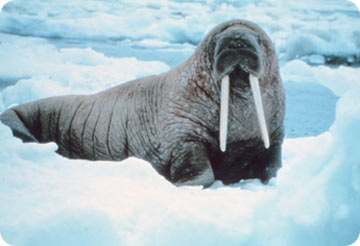A walrus is a big pile of blubber. That’s not an insult -- it’s a matter of survival. During the winter, blubber can make up up to a third of a walrus’s body mass. That keeps the walrus toasty warm as it slices through frigid waters.
 Walruses use blubber to keep warm. Credit: National Oceanic and Atmospheric Administration
Walruses use blubber to keep warm. Credit: National Oceanic and Atmospheric AdministrationBlubber is just one way that marine mammals keep warm. Others include dense fur and tapered bodies. And if all else fails, they can always do what snowbirds everywhere do and flee to a warmer climate.
These strategies are critical because water is much denser than air, so it carries away heat about 25 times faster. Without proper insulation, marine mammals would freeze in a hurry.
For walruses, whales, sea lions, and many others, that means thick layers of blubber -- a combination of fat and strands of connective tissue. Some whales have layers that are up to two feet thick.
Sea otters have no blubber. Instead, their skins are covered with dense fur -- up to a million hairs per square inch. That traps a layer of warm air next to the skin.
Most marine mammals have tapered, streamlined bodies -- like fat torpedoes. That shape means there’s less surface area to carry off the heat.
And when the water gets really cold, many animals simply head for warmer weather. The humpback whale, for example, feeds in Arctic waters during the summer. But during winter, it heads for the warm waters of Hawaii to give birth. And they don’t need to eat when they get there. They just live off their blubber -- a layer of insulation that keeps them going through all kinds of weather.

